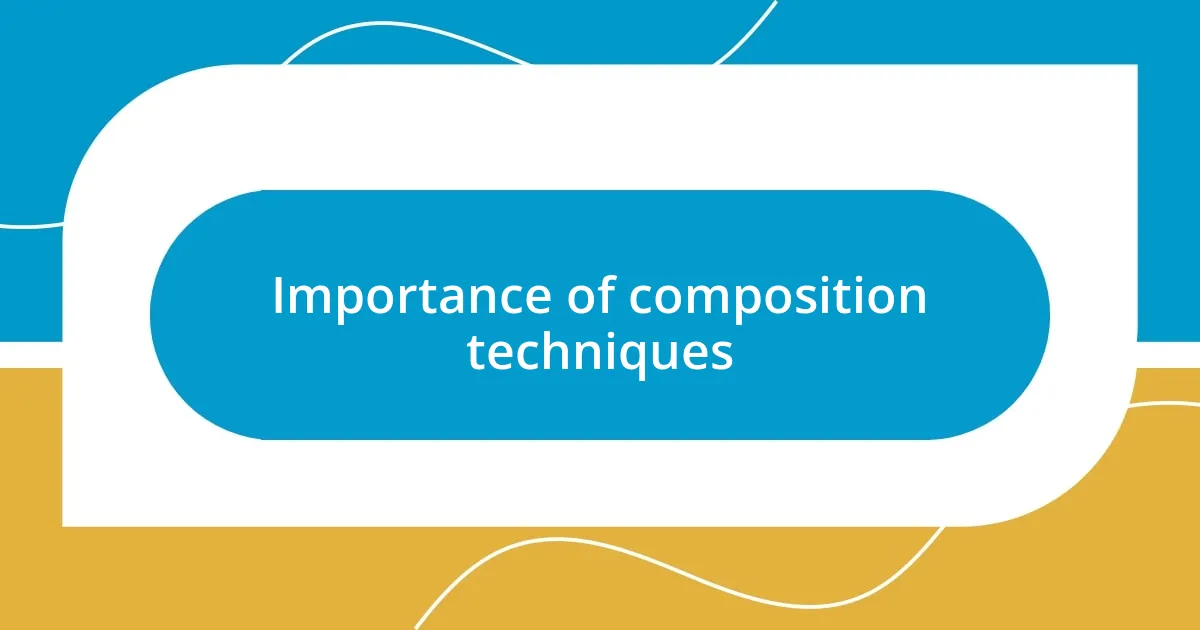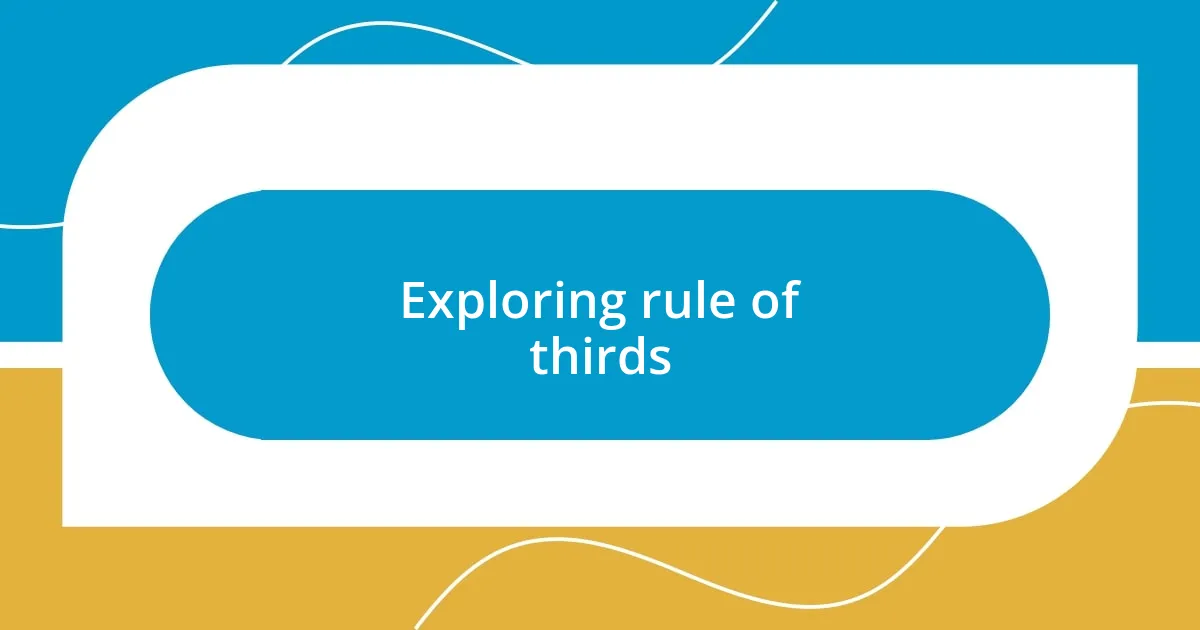Key takeaways:
- Understanding and applying composition techniques like the rule of thirds, leading lines, and negative space can significantly enhance the emotional impact and narrative of artwork.
- Key principles such as balance, contrast, and unity help artists create compelling compositions that resonate with viewers.
- Experimentation with different styles and perspectives fosters creativity and encourages artists to express their unique voice through composition.

Understanding composition techniques
Understanding composition techniques is truly a journey. When I first began exploring this aspect of art and writing, I often felt overwhelmed by the variety of methods available. It’s fascinating how something as simple as where to place a subject can dramatically change the mood of a piece. Have you ever noticed how a well-placed focal point can draw you into the story behind the artwork?
In my experience, mastering composition techniques like the rule of thirds or leading lines can transform a mundane photograph into something evocative. I remember an early attempt I made with the rule of thirds—I positioned a lone tree off to the side, and suddenly, the image had depth and intrigue. I often wonder, how did I ever overlook the power of such basic principles?
It’s essential to understand these techniques not just as rigid guidelines, but as tools that can be bent or broken to convey your unique voice. For instance, I sometimes find myself leaning towards asymmetry to create tension or draw attention. This balance of intuition and technique is what makes composition an art form in itself. What compositions resonate with you the most? Understanding why can open up new pathways in your creative expression.

Importance of composition techniques
Composition techniques are vital in art and writing, influencing how we perceive and interpret a piece. From my experience, techniques like framing can significantly enhance the context. When I applied framing in a landscape photograph, I discovered that it drew attention to the main subject. This simple adjustment made the image feel more immersive and directed the viewer’s gaze.
I’ve often marveled at how good composition organizes elements in a way that communicates a clear narrative. For instance, I recall a time when I experimented with negative space in a painting. By intentionally leaving areas empty, I was able to create breathing room that allowed emotions to resonate more freely. It’s amazing how smart placement can evoke feelings—like nostalgia or excitement—just through silent spaces.
Understanding these techniques enriches an artist’s toolkit, enabling more profound connections with the audience. I think about the emotional impact of balance versus chaos. In my art, I’ve found that strategically breaking conventional rules can lead to surprising results—like invoking curiosity or discomfort. It’s these moments that challenge the viewer, prompting them to reflect more deeply on what they’re seeing.
| Technique | Importance |
|---|---|
| Rule of Thirds | Enhances visual interest by creating balance |
| Framing | Directs viewer’s focus, adds context |
| Negative Space | Creates emotion, allows elements to breathe |
| Leading Lines | Guides the viewer’s eye, establishes movement |

Key principles of composition
Understanding the key principles of composition opens up a world of creative possibilities. From my early days of experimenting with different techniques, I realized that elements such as balance, contrast, and unity can transform a simple arrangement into a compelling narrative. For instance, I once worked on a project where I deliberately skews balance by clustering elements on one side. The resulting tension evoked a sense of movement that felt alive, capturing the viewer’s attention and curiosity.
Here are some fundamental principles that I believe every artist should consider:
- Balance: Achieving visual stability through symmetrical or asymmetrical arrangements.
- Contrast: Highlighting differences in color, shape, or size to draw attention.
- Unity: Creating cohesiveness among elements to present a unified message or feeling.
- Emphasis: Using standout features to ensure the focal point captures the viewer’s eye.
- Rhythm: Establishing a flow that guides the viewer through the composition and creates a dynamic experience.
The interplay between these principles can evoke emotions and narratives in ways that resonate long after the viewer has stepped away. For example, I recall a time I chose to emphasize a single, vibrant flower against a muted background. The stark difference left a lasting impression, reinforcing the message of beauty amidst simplicity. It’s moments like these that remind me of the power composition holds in storytelling—and the endless exploration that lies ahead.

Exploring rule of thirds
The rule of thirds is a fascinating technique that enhances the visual interest of an image. I remember a sunset I captured over the lake, where placing the horizon along a third created a sense of depth that felt almost dreamy. It drew the viewer’s eye naturally across the landscape rather than just staring at the middle of the frame, which can sometimes feel stagnant.
When I first began using this technique, I often wondered why it worked so effectively. The magic lies in how it encourages balance while allowing for creativity. I recall experimenting with a portrait by positioning the subject’s gaze along one of those imaginary lines. The result was striking—suddenly, the photograph had a narrative element that invited the viewer into a conversation with the subject.
In my experience, placing focal points on these intersections can lead to surprising emotional responses. For instance, during a recent hike, I snapped a photo of a solitary tree against a vast sky. By aligning it with one of the intersecting lines, I managed to capture not just a scene, but a feeling of solitude and stillness. It made me realize how a simple adjustment, grounded in such an easy-to-remember rule, can elevate an image from ordinary to extraordinary. Have you tried it yourself? It’s one of those techniques that can transform the way you see composition in everyday life.

Utilizing leading lines effectively
Utilizing leading lines effectively in your compositions can truly guide the viewer’s eye through the narrative you wish to tell. I once experimented by positioning myself at a train station, capturing the tracks that led off into the distance. The way those lines converged made the viewer feel like they were being pulled into an endless journey. It’s incredible how something so simple can evoke such a strong sense of motion and anticipation.
I often encourage others to think about the natural lines in their surroundings, whether they’re roads, fences, or rivers. These elements can create a pathway, guiding the viewer towards the focal point of your image. I remember walking through a forest and discovering a beautiful winding path. By framing my shot to include the path leading into the dense trees, I not only invited the viewer into that world but also sparked a sense of adventure. Have you ever noticed how leading lines can enhance the mood or story behind a photograph? It can transform an ordinary scene into a captivating experience.
When I focus on leading lines, I pay attention to both their direction and their emotional impact. For example, a diagonal line often conveys dynamism, while a horizontal line feels calm and stable. There was a time I captured a serene lakeside view with a calm horizon line that grounded the composition beautifully. I felt like the photograph radiated tranquility, and I remembered how peaceful that moment was. This interplay of lines can elevate your work to speak volumes, leaving viewers not just seeing but feeling.

Balancing elements in composition
Finding balance in composition is like walking a tightrope; it’s about harmony. I recall a time when I balanced a bright sunset with a dark silhouette of a tree, the contrast creating a visual tug-of-war that drew me in. Have you ever noticed how playing with such contrasts can elevate a mundane scene into something exquisite? It’s as if the tension between light and dark captures the essence of life itself.
In my experience, balancing elements like color, size, and texture is crucial for creating a captivating composition. I remember a photograph I took at a bustling market, where I captured bright fruits on one side and an intricately woven basket on the other. The vibrant colors of the fruits played against the natural tones of the basket, making each element stand out while still feeling cohesive. It taught me that each component contributes to a greater whole, shaping the viewer’s emotional response.
I often find that achieving balance isn’t just about symmetry; it’s also about the relationship between the elements. Once, I photographed a couple walking hand-in-hand on a beach at sunset, with waves crashing on one side and the sun setting on the other. The movement of the waves complemented the couple’s intimacy, creating a compelling narrative. It made me ask, how can we use these balances in our everyday shots to tell deeper stories? Engaging with these elements can transform your photographs, fostering a connection between the viewer and the essence of the scene captured.

Experimenting with composition styles
Experimenting with different composition styles can feel like unlocking new doors in your creativity. I remember deciding to play around with the rule of thirds one afternoon while capturing street life in a vibrant city. I framed my shot to place the bustling sidewalk on one side, contrasting it with a serene park bench on the other. The unexpected harmony created a visual dialogue between movement and stillness that resonated with me. How do you think such juxtaposition can change the narrative of an image?
I also often dive into unconventional angles when I’m trying to capture a scene. One particular moment was during a rainy day when I decided to crouch low and shoot upwards through the raindrops clinging to a puddle. This choice of perspective transformed a simple street scene into a mini-world of reflections and colors. I found myself immersed in the tiny bit of chaos of the rain, with my heart racing at the creativity just waiting to unfold. Have you ever explored an unorthodox viewpoint that turned a static scene into something dynamic?
The beauty of experimenting with composition styles lies in the unexpected lessons we uncover along the way. I once dabbled in negative space, which felt foreign at first. By deliberately leaving much of the frame empty, I asked the viewer to contemplate what was missing. I showcased a lone flower against a vast expanse of blurred green, and the simplicity struck an emotional chord that lingered after the initial view. I began to wonder, how can negative space transform the focus of your work and evoke deeper emotions? Embracing these experiments has enriched my perspective and deepened my appreciation for the art of composition.














